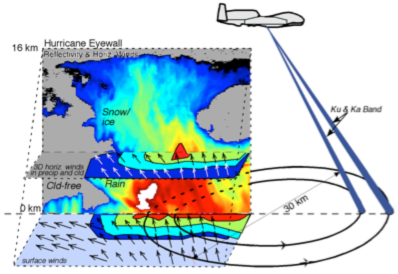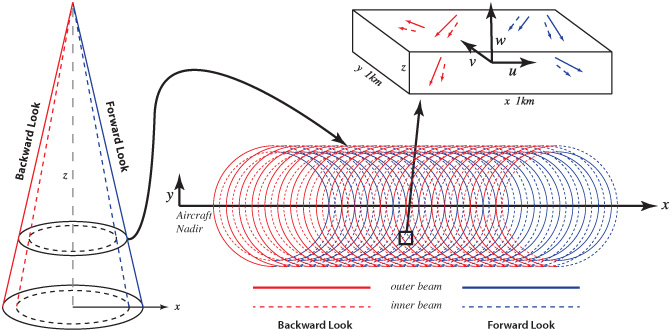HIWRAP
Instrument Description
 HIWRAP is a dual-frequency (Ka- and Ku-band), dual-beam (300 and 400 incidence angles), conical scan, solid-state transmitter-based Doppler radar system. It was designed for operation on the high-altitude (20 km) Global Hawk UAV. HIWRAP utilizes solid state transmitters along with a novel pulse compression scheme. This results in a system that is considerably more compact in size, requires less power, and ultimately costs significantly less than typical radars currently in use for clouds and precipitation observation. HIWRAP is able to image the winds through volume backscattering from clouds and precipitation, enabling it to measure the tropospheric winds above heavy rain at high levels. HIWRAP was completed in 2010 and it has flown test flights on the NASA WB-57 under the NASA Instrument Incubator Program, and then went on to perform science flights on the NASA Global Hawk in support of the NASA Genesis and Rapid Intensification Processes (GRIP) field campaign in Summer 2010, and on the NASA ER-2 in support of the GPM Mid-Latitude Continental Clouds Experiment (MC3E) in May 2011.
HIWRAP is a dual-frequency (Ka- and Ku-band), dual-beam (300 and 400 incidence angles), conical scan, solid-state transmitter-based Doppler radar system. It was designed for operation on the high-altitude (20 km) Global Hawk UAV. HIWRAP utilizes solid state transmitters along with a novel pulse compression scheme. This results in a system that is considerably more compact in size, requires less power, and ultimately costs significantly less than typical radars currently in use for clouds and precipitation observation. HIWRAP is able to image the winds through volume backscattering from clouds and precipitation, enabling it to measure the tropospheric winds above heavy rain at high levels. HIWRAP was completed in 2010 and it has flown test flights on the NASA WB-57 under the NASA Instrument Incubator Program, and then went on to perform science flights on the NASA Global Hawk in support of the NASA Genesis and Rapid Intensification Processes (GRIP) field campaign in Summer 2010, and on the NASA ER-2 in support of the GPM Mid-Latitude Continental Clouds Experiment (MC3E) in May 2011.
HIWRAP has two modes of operation: Global Hawk with scanning, and ER-2 in a fixed nadir pointing configuration.
 Figure 1.1 HIWRAP measurement concept
Figure 1.1 HIWRAP measurement concept
Illustrated as Figure 1.2, for any given volume cell within the inner swath, HIWRAP will view this cell at both Ku and Ka-band from two different incidence angles and four different azimuth angles (forward and backward looking while the aircraft flies over the cell), from which the 3 components of the wind are derived. Due to aircraft ground speed and storm system winds, Doppler measurements are potentially folded for some volume cells. Different techniques, such as geometry correction, Dual-PRF and frequency diversity Doppler processing [7], will be used for Doppler velocity unfolding. The measurement requirements for HIWRAP are given in Table 1.1 for wind retrievals in 1 km x 1 km x 60 m pixels.
The two incidence angles, 30 and 40 degrees, were chosen based on a numerical analysis performed by RSS for combinations of derived horizontal wind accuracies versus incidence angle. These two angles maximized the number of “good” retrievals that could be obtained over the expected swath of HIWRAP, where “good” retrievals were defined as retrievals with a standard deviation of less than 2 ms-1. [9]
 HIWRAP measurement concept is illustrated where blue and red lines represent fore and aft look and solid and dotted lines represent inner and outer incidence angle.
HIWRAP measurement concept is illustrated where blue and red lines represent fore and aft look and solid and dotted lines represent inner and outer incidence angle.
The measurement requirements for HIWRAP are given in Table 1.1 for wind retrievals in 1 km x 1 km x 60m pixels. The actual line-of-sight wind measurement accuracy is much smaller than the retrieved wind accuracy.
|
Parameter |
Range |
Accuracy |
|
Horizontal Wind Speed |
0-100 m/s |
2 m/s |
|
Horizontal Wind Direction |
0-360 deg |
15 deg |
|
Ocean Surface Wind Speed |
0-60 m/s |
2 m/s |
|
Ocean Surface Wind Direction |
0-360 deg |
15 deg |
|
Vertical Wind Speed |
+/- 20 m/s |
2 m/s |
Table 1.1: HIWRAP Retrieval Performance Requirements
|
Parameters |
Specifications |
|
|
Ku-band |
Ka-band |
|
|
RF Frequency (GHz) |
Inner Beam: 13.910 |
Inner Beam: 35.560 |
|
Transmitter Peak Power (W) |
25 |
8 |
|
3 dB Beam Width (o) |
2.9 |
1.2 |
|
Polarization |
Vertical (outer beam), Horizontal (inner beam) |
|
|
Minimum Detect. Reflectivity (dBZe, 60 m resolution, 10 km range and 3 km chirp pulse) |
0.0 |
-5.0 |
|
Dynamic Range (dB) |
> 65 |
|
|
Doppler Velocity (ms-1) |
0-150 (Accuracy < 1.5 ms-1 for SNR>10) |
|
|
Scanning |
Conical Scan, 10-30 rpm |
|
Table 1.2. HIWRAP Top Level Performance Requirements
The design of HIWRAP involved compromises in order to address the scientific requirements and hardware limitations imposed by the size, power, and weight constraints of the Global Hawk platform. A number of factors, such as the high altitude environment, limited space, weight and power posed challenges to system design. The entire radar system must have the capability to operate in a “turnkey” autonomous operation mode. There are a number of features of HIWRAP that have not been previously been utilized in airborne precipitation radars:
- First unpressurized, high altitude Ku/Ka-band Doppler Radar.
- Dual beam conical scan enable 3D wind retrieval.
- Unique use of sidebands supports two simultaneous beams to minimizes size and power.
- Ka-band dual power amplifier assembly design eliminates high power switches in transmitter.
- Supports adaptive pre-distortion pulse compression schemes for ultra-low range sidelobes.
- Unique internal calibration circuit provides independent monitoring of transmit, receiver and full transceiver transfer function and provides a Dicke-Hatch mode for measuring atmospheric and surface emission (can be used in a radiometer mode).
- Very high compression points in transmitter and receiver enable transmit power amplifier in near future to achieve +16 dB sensitivity improvement.
- Versatile transmission waveform generation: dual PRF, linear FM chirp pulse and frequency diversity pulse compression, pulse amplitude tapering for range sidelobe reduction.
- Programmable timing source for the digital receiver, transmitter and RF switches.
- No blind region, frequency diversity pulse compression & Doppler processing (high Nyquist sampling, long range).
